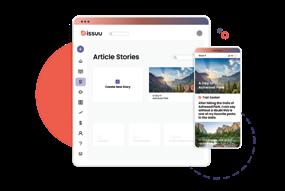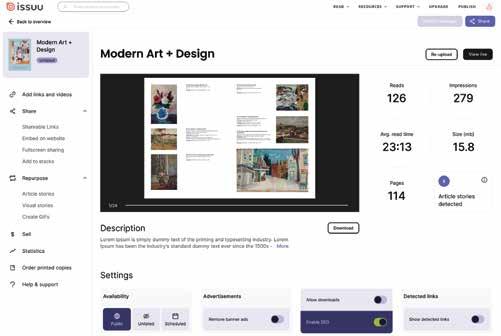The Democratization of Technology & Design:
Giving Creators and Marketers the Tools to Succeed

There’s an endless stream of buzzwords and phrases that fly around in the business world. Perhaps none is quite so pervasive as the democratization of technology these days. This seismic shift in the way people work and the tools they use to accomplish their jobs is impacting nearly every department in all industries across the globe. No wonder everyone is talking about it.
It’s time to unpack what the phrase really means, why this trend is here to stay, and how it extends into the design and content marketing world. We’ll also highlight the self-service tools that make creating, publishing, and sharing easier than ever via a seamless workflow, enabling enterprise marketers and solopreneurs alike to transform a single piece of content into a library of powerful assets with real ROI (yes, it’s possible!). Ready to discover how? Let’s go. ��

1.
Democratization...
What’s That About?
Technology continues to advance at an unprecedented rate, and it’s being democratized in the process – meaning the power to program, code, invent, and create is accessible to all of us. And that’s an enormous thing. This is especially true when it comes to the creative world of design and content marketing. Now anyone, not just a team of highly skilled experts, has the chance to get involved in the technology (r)evolution at their companies, particularly when it comes to designing, publishing, and sharing meaningful content across channels. Gartner recently put the democratization of technology — that is, providing people with easy access to technical or business expertise without extensive (and costly) training — on their list of 10 strategic technology trends. Accenture’s Technology Vision 2021 report stated, “With democratized technology, every employee can be an innovator, empowered to create technology-driven solutions on their own.” This level of accessibility and the flexibility to make changes on the fly is especially crucial as companies across all industries seek to do more with less.
Why It Matter Now More Than
In a time of global economic uncertainty, many organizations cannot afford to retain 20+ person in-house design and
marketing teams with a bevy of expensive software solutions. Brands need to continue creating and sharing content to stay ahead of the competition, but they have less people, tighter budgets, and fewer overall resources to make it happen.
At the same time, the creative world is rapidly changing, and companies can either move forward or stand still and get left behind. As a result of the myriad of digital design platforms, new standards of design have catapulted this lucrative market to grow to over $45.8 billion, and it won’t stop there. Today, there is a growing demand for design and distribution to be placed back into the hands of individuals, urging software companies to supply accessible products that allow anyone to become their own creator. Adobe agrees that it’s far more than a passing trend, stating:
As the name implies, content democratization allows individuals and small businesses to create and share digital content in more ways than would have been possible in the past. It eliminates previous limitations of the traditional media space, such as price and technology barriers that restricted content creation and sharing to fewer people.
2.
Ever
Brands need to continue creating and sharing content to stay ahead of the competition, but they have less people, tighter budgets, and fewer overall resources to make it happen.
The Impact on Design and Marketing
Inflation is soaring right alongside democratization and has small business owners rethinking their design and content marketing strategies. Now at a 30-year high, inflation is forcing companies to either absorb increased costs and sacrifice margins or raise prices and depress demand. As nearly half of SMBs try to navigate content creation and marketing efforts on their own, they’re likely to run into various challenges that may hinder their efforts – and, in turn, they’ll start looking for better solutions.
Even for legacy media companies (like newspapers, magazines, broadcast television, and radio), the democratization of content has led to continued declines in subscriptions and viewers paired with skyrocketing printing expenses. But the battle being fought by “old school” outlets can be negated by disseminating content in new ways – like on social platforms and through online magazines. Adobe weighs in:
If [traditional media companies] don’t go digital, they’re unable to deliver the type of content people are craving, where they crave it. And if these companies do deliver content online, thanks to paywalls, ad blocking software, and changing customer preferences, these companies can still see their influence wane.
There are four critical pain points that must be addressed in any content marketing strategy: creating content, publishing,

3.
sharing, and measuring results. These challenges can seem daunting. But luckily, feasible solutions exist to solve all of these concerns.
distribute it with similar professionalism as industry giants like Amazon or Target without the cost – and often with greater flexibility and efficiency.
Design and publishing companies are taking notice, adapting their current offerings to support this growth and empower individuals to tap into their creative potential. Today’s creatives, entrepreneurs, and savvy digital marketers are quick to take advantage of free or low-cost online creation and distribution platforms in order to reach people across channels. These efforts are monetizable and can attract a large following fairly quickly.
Users, and Teams
We’re entering a new age. Democratization is paving the way for organizations everywhere to leverage cost-effective, intuitive platforms that nearly anyone can use. This phenomenon enables everyone to be a content creation and marketing guru.
These days, what can be accomplished with a $2,000 computer and self-service SaaS tools surpasses the capabilities of million-dollar budgets and complicated software from decades past. With the right set of tools, an individual creator or one-person marketing team can make content and share and
Forward-thinking brands should follow suit. Those who adopt easy-to-access-and-use solutions free themselves from relying on a single department and decentralize the power to make changes. As a result, they can expect these kinds of changes:

� Digital content that is accessible from anywhere, on any device, with a static URL – whether shared publicly or privately with internal teams
� The ability to make changes in an instant, keeping documents current and correct
� Omnichannel content marketing becomes easier and easier
� A total overhaul of the way people work, speeding up the time from ideation to publication
It’s time to make technology work for you, and the tools exist to make it happen.
4.
= Do More with Less
Too many creators’ workflows are tangled and overcomplicated by a web of disparate, expensive solutions, which can look like this:

Design platforms and the people that use them can adopt new comprehensive, universal offerings to market themselves and their work, ultimately driving more revenue than before. There are plenty of budget-friendly options available that can help creators and marketers scale their businesses, many of which simultaneously enable them to streamline, automate, accelerate, and analyze their efforts flawlessly.
Pre-existing templates and designs simplify the process so that designers and marketers don’t have to allocate funds toward extensive graphic design support and other creative tools. These templates can also be customized to easily create

Work
5.
Put Technology to
Create Publish Share Analyze Figma $45/mo Sellfy $119/mo Repurpose.io $125/mo Google Analytics $$ VistaCreate $10/mo Flipsnack $79/mo Buffer $120/mo Klipfolio $99/mo Prezi $64/mo FlipHTML5 $83/mo Sprout Social $399/mo Parse.ly $$ Ceros $$ Flippingbook $88/mo RELAYTO $600/mo Paperflite $50/mo
on-brand marketing assets that will increase engagement and drive website traffic.
With trusted tools such as Canva, InDesign, MailChimp, Hootsuite, and Issuu, effective content creation and distribution is easier than ever before. By utilizing well-integrated tools such as these, users can craft content, distribute it to eager audiences, engage with their followers and customers, monetize their work, build partnerships, run the back end of their business, and so much more – all dependent on the use of an efficient, frictionless workflow.


A seamless end-to-end workflow for creating, publishing, sharing, and analyzing content looks like this:
When put into effect, the following business outcomes are seen:
� Smaller teams are empowered to punch above their weight thanks to a wider arsenal of tools
� Improved marketing ROI from having a greater reach across all channels
� Reduced tech sprawl combined with better tool adoption and utilization
� Improved productivity and lower time to market using a frictionless workflow
6.
The Loop of Luxury is the Future
By operating in this “loop of luxury,” where a few integrated tools can replace a complicated web of many, you can make your content work smarter, not harder.

Instead of creating content tailored to specific platforms, such as social media or company blogs, a single piece of content can be readily disseminated to global audiences across various digital channels. This new way of thinking and working will enable users to successfully reach large audiences and drive brand awareness at scale while ensuring brand voice remains consistent across all content and platforms to boost messaging and marketing.
Content creation and publishing is no longer a strenuous effort for SMB designers and marketers. Here’s an example of an incredibly efficient workflow:

1. Create in Canva or Adobe InDesign



2. Publish directly to Issuu as a dynamic flipbook

3. Generate a suite of assets, like mobile-optimized Articles and Social Posts
4. Share on social media with Hootsuite

5. Measure the impact of your content with built-in Statistics
This process helps users ensure that they’re sharing unique, interactive content that’s relevant to their target audience and prioritizes cross-platform optimization. Ultimately, it’s about getting the content to audiences, as efficiently as possible, wherever they are.
And implementing smart tech solutions will not only help you create and publish omnichannel content more efficiently but measure it, too. In a digital world that’s
http://...

7.
saturated with content from millions of brands, the pressure to be everywhere all at once is high. Over one third of small businesses spend less than $10k on advertising and marketing efforts in a calendar year, so they need to ensure that their spend is reaching the right audiences and impacting their revenue goals. That’s where built-in reporting and analytics becomes a must-have when evaluating SaaS solutions.
perfect and publish it, and sales can access and share it with prospects. With Issuu, dedicated users can manage multiple publisher profiles with unique URLs for every segment of the business, keeping content organized by location or department.
Savvy professionals should start planning ahead now; evaluate current tech stacks, processes, strategies, and budgets. By making the switch to solutions that fit into a seamless workflow, designers and marketers across industries can start creating more effective content that can easily be published and shared on all channels to drive long-term success.
Platforms like Issuu provide built-in, real-time analytics tools for users to track, measure, and report on the success and effectiveness of their content marketing efforts. This is an efficient way to tie marketing spend to results (to ultimately reduce the total amount of spend required), and these crucial insights can help inform future strategies. Additionally, it’s one more way to further streamline tech stacks and workflows, so the entire creation-transformation-publishing-reporting process remains in the loop of luxury.

Adopting and implementing better (and fewer) solutions will address critical pain points when it comes to sharing great content. Additionally, by putting entire teams on one solution that lives at the center of all other efforts, you bring meaningful content into the fold of the rest of the business. Designers can upload their work, marketers can
As the barriers to getting the necessary tools continue to disappear, the opportunities to enhance content and its respective marketing with real ROI are limitless.
Attention-grabbing digital content is no longer just for highly skilled teams of 10 or more. As the barriers to getting the necessary tools continue to disappear, the opportunities to enhance content and its respective marketing with real ROI are limitless. If you’re ready to optimize your content marketing efforts, fix the pain points when it comes to design and distribution, and be incredibly nimble in reaching audiences around the world, Issuu is the solution you’ve been looking for.
Book a demo to see why.
8.
About Issuu



Issuu is the world’s largest content publishing and marketing platform that empowers people to convert, host, and share engaging content in a variety of dynamic formats across all digital distribution channels. With 60M+ publications, Issuu makes it easy for its 1M+ global users to transform a piece of content once, and share it everywhere.
The Issuu Story Cloud turns a single document into a uniquely immersive reading experience by converting static documents into marketing assets – including flipbooks to embed in websites and blogs, mobile-optimized articles, motion-graphic stories for social media, GIFs for email, and more. Each day, more than 300,000 pages of content are uploaded to Issuu, allowing readers worldwide access to discover and engage with more of what they love, from magazines and newspapers to portfolios and catalogs.
Enterprise marketers and individual creators alike choose Issuu for its user-friendly platform that puts their message front and center without requiring a single line of code. Issuu is headquartered in Palo Alto, CA, with global offices in Copenhagen, Berlin, and Braga. Learn more at issuu.com.

9.






















